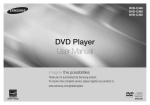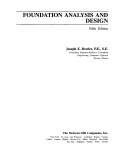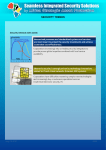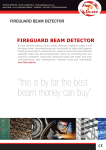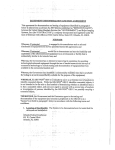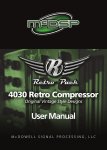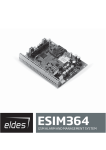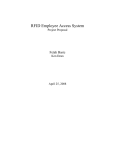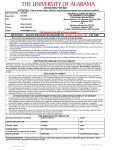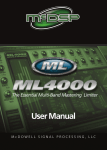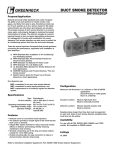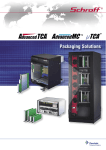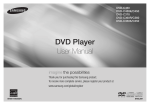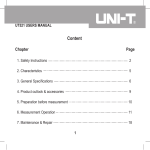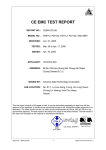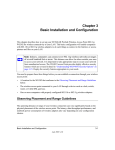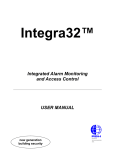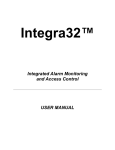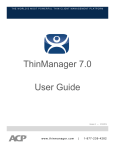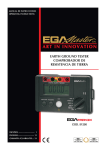Download ASAP Brochure 090122 - ASAP Africa Strategic Asset Protection
Transcript
ASAP WE DO N ’T S E LL P RO DU CT S , WE PROVIDE SOLUTIONS! page 1 of 100 ASAP COMPANY PROFILE Our Mission Statement Africa Strategic Asset Protection (ASAP) is an Information Communications Technology (ICT) based Security Specialist Company operating in the Security, Risk Management and Loss Control fields. We provide innovative and integrated ICT Enterprise Security Management Solutions in South Africa and abroad. This we do by: • Doing continuous research in this specialized environment and providing the best possible solution for our clients; • Providing a professional service combined with high professional standards and staff; • Ensuring a safe, uplifting and secure environment for our clients by installing appropriate security solutions and making all their employees ‘shareholders’ thereof. • Providing our employees the opportunity to be creative and innovative and in the process developing them and at the same time improving the solutions and services we provide. page 2 of 100 ASAP COMPANY PROFILE Our Background Africa Strategic Asset Protection (ASAP) cc was established in 1998 and at the time started off by providing Physical Security Solutions. In 2000 we started researching and exploring ICT solutions in the Security Sector and our search took us all over the globe to bring together ICT security solutions that met and exceeded the requirements and expectations of our customers. We brought out the best with regards to Access Control, CCTV Surveillance and Asset Tracking from different vendors. Through our endeavors and sound partnerships we brought these vendors together to integrate their solutions into an Enterprise Security Management Solution that caters for the needs of large corporate companies, government bodies and the SME sector. ASAP is a proudly South African Black Owned ICT company, able to deliver a world class integrated solutions as required by our clients. In addition Africa Strategic Asset Protection (ASAP) has successfully completed a number of very large projects in various centres in South Africa. Where the installation’s guarantee period has expired, they have successfully negotiated ongoing maintenance contracts. ASAP installed base for Enterprise Security Management Solutions over the last four years represents a Rand value of R503 million and are as follows: • • • Video & Surveillance –1500 cameras Access Control – 2100 access control points Asset Tracking – 14 000 personnel and asset tracking tags page 3 of 100 ASAP COMPANY PROFILE Our Solutions Our key focus centers on the following: Enterprise Security Management Our solution seamlessly integrates Access Control Management, Alarm Monitoring, Live Video CCTV Monitoring, Elevator Control, Parking Control, Building Systems Control and Intercom Interface. The core of our Enterprise Security Management Solution is Axiom V which seamlessly integrates with our preferred surveillance solution Detec, but also integrates with just about any other reputable CCTV Monitoring Solution. Asset Tracking & Asset Control Our solution is based on Wavetrend’s Active RFID technology. Long read ranges; the ability to perform in harsh, wet and metallic environments; and the ability to transmit data make active RFID ideal for applications in aviation, construction, defense, healthcare and transport. Security Inspection Solutions (X Ray Scanning) Our core offering centers on THSCAN Systems and Technology. Solutions include amongst others Large Container/Vehicle Inspection, Baggage & Luggage Monitoring, Liquid Security Inspection System, Radioactivity Monitoring System, Explosives/drug inspection System and Mobile E-beam Security Systems. page 4 of 100 ASAP COMPANY PROFILE Our Clients Some of ASAP’s major clients are listed below: Department Of Public Works (National) Petro SA BP SA (National) Provincial Government Legislatures Coega Industrial Development Zone Works Department KZN Head Office Public Works: Eastern Cape Some of these installations/sites are classified as National Key Points. Our Industry Certification The industry we operate in is regulated by the Construction Industry Development Board (CIDB) and the Private Security Industry Regulatory Authority (PSIRA). With the CIDB ASAP has achieved the following certifications: Alarms, Security & Access Control Systems – 7SA Fire Prevention & Protection Systems – 4SF General Building Works – 6GB Our staff has also attained the required level of required PSIRA certification to operate and support clients that are classified as National Key Points. Our Empowerment ASAP is 67% owned by Black South Africans and has extensive experience within the security industry and is one of a few companies that have a 7SA rating from the Construction Industries Development Board (CIDB). Our Locations ASAP is in position to provide a service on a national basis as we do have a corporate office in Cape Town with regional offices in Johannesburg, Durban and Port Elizabeth. Our Contact Detail If you enquire any further information then please do not hesitate to contact us: • • • • • 103 Kyalami Drive Killarney Gardens +27 21 556 9313 E-mail: [email protected] Website: www.afrisap.co.za page 5 of 100 ASAP THE EVOLUTION OF SECURITY 1997 Security handled as additional part of the building infrastructure •locally delivered through guards •focus on intrusion prevention •independent from business processes •independent from IT systems and networks Evolution of Security 2000 Security considered as technology related building investment •delivered through guards, selectively replaced by technology •still strong focused upon prevention of intrusion •included in investment roadmap but not linked to existing business processes •selectively related to IT organization 2002 Security evolves into a critical success (survival) factor for corporations •Senior management focus, driven by conscious risk management •Regulated through legislation/ regulations under strong stakeholder/ media focus •Video surveillance rapidly replaces intrusion detection •Increasingly delivered through technology integrated into IT systems SECURITY TRENDS Protecting Business Processes, People and Assets Protecting business continuity •Increased awareness -> assessment and management of risks •Security customized to protecting business processes •Intrusion detection replaced by multi- level, -site surveillance Innovation •Security related technology is rapidly evolving and requires proactive life cycle management •Savings from process improvements will be used for further investments (Return of Security Investment) •Centralized controlling and proactive management of security operations Common Misconception A common misconception is to consider technology as the driving force for a Integrated Electronic Security Strategy page 6 of 100 ASAP SECURITY TRENDS Capability to integrate physical and logical (IT) security is a key issue Complete portfolio for security requirements page 7 of 100 ASAP SECURITY TRENDS Combining technical, solution, business process know-how fulfils customer needs and fosters efficiency page 8 of 100 ASAP SECURITY TRENDS Integrated measures to prevent problems shifting Integrated security solutions for mass events – example page 9 of 100 ASAP SECURITY TRENDS Integrated security solutions for mass events – example Entrance control and observation of people flow including ‘Blacklist search’ applied globally page 10 of 100 ASAP SECURITY TRENDS Inside video systems enable centralized observation supported by face recognition systems A state-of-the-art security solution ensures business continuity and Investment protection across the entire life cycle page 11 of 100 ASAP SECURITY TRENDS Security interacts with processes Security interacts with people page 12 of 100 ASAP SECURITY TRENDS Security interacts with assets page 13 of 100 ASAP DETEC - CCTV page 14 of 100 ASAP DETEC - CCTV Product highlights • A Detec network can consist of an unlimited number of Detec clients and Detec servers, supporting as many cameras as required. • The Detec client functions both as a control interface and as a central management system. The Detec server acts as central database of recorded events. • Remote monitoring via ADSL, ISDN, LAN/WAN, SMS, MMS and e-mail. • Detec alarms and associated images can be sent to PCs, cell-phones or PDAs. • Detec can be used with any combination of analogue coaxial or digital IP-based CCTV cameras. • Pan, Tilt and Zoom (PTZ) controls available from the Detec client interface for suitably equipped PTZ cameras. Multiple PTZ protocols supported. • Stores alarm sequences with user defined pre-alarm and post-alarm durations. • Unique disc file system that provides a smart solution to handle failed drives. • Event detection based on advanced mathematical algorithms, providing colour-image analysis with recognition of predefined objects and motion. • Algorithm parameters can be usermodified to detect objects or events in specific environments. • Possible to trigger alarms on unattended items, e.g. bags and suitcases. • Object character recognition (OCR) on e.g. vehicle number plates or container labels. • Image resolution from 192x144 pixels to the best resolution in the market with 768 x 576 pixels. • Can easily be integrated to other security systems. • Can replace video matrix systems. • Password-protected access to different user profiles. • Works with anti-virus programs on Windows XP Detec is a sophisticated, flexible, automatic video surveillance system, capable of detecting, recording and transmitting activity in virtually any setting requiring security. page 15 of 100 Detec is designed to be flexible The Detec client-server architecture allows a security centre to support one or more separate Detec systems, with an unlimited number of cameras, using only one Detec client interface. If a central security centre does not exist, a Detec system can be managed from several different Detec clients in different locations, i.e. monitoring may be performed locally, on site, or remotely via telecommunication links. This drawing shows how flexible Detec can be. Here you see two systems that are supported by several clients, both PCs and a PDA. At the same time you will see that one client is connected to both the systems. ASAP DETEC - CCTV page 16 of 100 ASAP DETEC - CCTV page 17 of 100 ASAP DETEC - CCTV Key Selling Points – Detec systems What are the Detec systems’ features and what benefits do they offer the customer? Features Full network flexibility Benefits Allowing a sufficient number of cameras, servers and client PCs to cover critical areas Central management system with user-friendly Allowing you to easily monitor sites, as well software as searching, playing back, archiving and copying recorded alarms Advanced and accurate video detection module based on mathematical algorithms, providing statistical colour-image analysis. You can easily avoid unwanted recordings of events of no interest, or on the other hand, make sure that you do not miss any events that occur. The accuracy of the detection module leads to recognition of predefined objects, their shape, and in what direction these objects move (tracking). Has proven capabilities in numerous different environments. Colour based detection The detection is much more accurate by the fact that it can separate between objects and backgrounds based on colour image analysis, and reduces potential analysis problems that may occur because of shifting surroundings (light, clouds etc). Most competitors use video detection based on grey-scale image analysis. Events are stored with a variable pre- and You can easily investigate the whole event, continuous post alarm sequence (as long as the both what happened before and after the alarm object that triggered the alarm is in the image) image itself Possible to define alarms on unidentified, still- Makes it possible to detect left-behind objects, standing objects such as suit-cases and cars in critical areas, and in that way reveal bomb-threats. Optional I/O-module Integration with other security systems page 18 of 100 Easy to integrate the system with other technical security systems Enhances functionality and standard of security operations ASAP DETEC - CCTV Module communication over a TCP/IP interface Makes it operational in any network based on TCP/IP technology, such as ADSL, SHDSL and ISDN over remote distances, and LAN/ WAN and Ethernet in more constrained areas. Hence, the monitoring may happen locally or remotely. The technology makes it possible to use both IP-cameras and conventional analogue cameras. Supports both analogue and digital cameras The system may be used with both more conventional cameras as well as the IPcameras of tomorrow. This means that customers can make a gradual investment in new equipment. Supports megapixel cameras from multiple Megapixel cameras give much better manufacturers restoration of details, making it easier to identify persons, license plates, events etc. Zoom tools work very well. Megapixel cameras work very well on moving objects. Support for several PTZ camera protocols You can easily integrate different brands of through several I/O interface options PTZ cameras and make full use of their functions through Detec’s graphical user interface Separate user interfaces for PDAs and 3G cell Alarm sequences can be received on PDAs phones supporting JAVA technology and cell phones while ”on the move”, providing increased personnel redeployment and mobility, which in turn leads to greater security coverage. Unique disc file system You can avoid losing all data if storage discs should be defect, through a unique security solution exclusive to Detec. It provides another solution to failed drives than pure RAID. However, RAID solutions can also be implemented upon request. Image resolution from 192x144 pixels to You can determine whether high image megapixel resolution resolution is important or not, and in cases where the image resolution is crucial, the image quality and details will be very well represented. In cases where resolution is not that important, you can reduce it and save events for a longer period as you allocate more storage capacity. Password protected access to different user Helps maintain system set up and keeps profiles distribution of information safe page 19 of 100 ASAP DETEC - CCTV Works with anti-virus programs on Windows Protects the system against viruses, which XP makes the system stable. Detec run on an operating system well known for most users, which reduces training costs. Flexible system for information distribution Alarm sequences and images can be presented and distributed to PCs, cell phones or PDAs, either as Detec archive files, SMS, MMS, Email or printouts. If you write Detec archive files to a CD from Detec’s user interface, a program for playing back the files will automatically be attached. Camera positions can be placed in maps When placing camera icons in maps you can quickly identify where an event occurs. Possible to create commands that can be Makes it easy for guards to react to events by displayed as buttons in the camera image simply clicking a button to perform a command or set of commands. E.g. you can make command buttons to open doors in a scene where a camera points towards an entrance. Time-controlled automatic archiving Releases operators from manual archiving. Archiving can be done on hours when events are unlikely to occur. Export of recordings to video file formats Converted files (without watermark) can be played on any PC with a video file player, e.g. Windows Media Player Colour coded alarm lists Simplifies the work for guards monitoring the system, who will more easily be able to separate between type of alarms and can make a quicker assessment. The colour codes are logical in relation to what the system perceives an even to be. Supports 16:9 format resolution in full screen Detec can be used with both 4:3 and 16:9 view format LCD monitors Window layouts can be sent and received by a Makes it easy for an administrator to set up user clients within a network and determine what different users are able to see. It also simplifies setting up what to be viewed on monitors that does not have keyboard and mouse nearby, e.g. on displays in shops. Users can be forced to sign in and be Enhances user control and security automatically signed out when inactive User Interface connection to server on port User Interfaces can be connected to the server number or net address with both static and dynamic IP addresses page 20 of 100 ASAP DETEC - CCTV Where are Detec-systems being used? A few case-study examples. Customer Finnish Navy Akershus Fortress/ Royal Guard – Norwegian Army Norwegian Army Market Vertical Military Military Detec is used for general surveillance and perimeter security, including monitoring shoreline perimeter intrusion. Detec overcomes the challenges faced in maritime environments such as waves and water reflection, and only notify alarms on desired objects, such as boats, within specified regions. Confidential Military Confidential Bergesen LNG tankers Maritime Talisman Energy Ltd Offshore oilplatform Norwegian Parliament Public administration Kristiansand Port Transportation/ Port GE Health Care page 21 of 100 Description of application/system Industry Detec is used on board most of the Bergesen LNG tankers to detect oil and gas leakages in the vessels’ engine room at an early stage. Detec is used on offshore oil-platforms to monitor that flares do not extinguish. This is a specialized surveillance task that requires an alarm when motion is about to stop (so-called inverse detection), with high accuracy requirements. Confidential Detec systems is chosen by Kristiansand Port in order to prevent shoreline perimeter intrusion, monitor pier/dock/warehouse activity, vessel loading and unloading, monitor container area and vehicles and person entering the port. The system comprises of 68 Detec A camera licenses, 7 servers and two manned guard centres. There is a mix of analogue-, IP-, megapixel- and PTZ-cameras. The Detec system replaced the system of an international competitor that did not prove good enough. GE Health Care, Lindesnes, is one of the largest pharmaceutical factories in Scandinavia. GE Health Care, Lindesnes use Detec systems for perimeter security and operations surveillance, and the system comprise of 5 servers, with a combination of analogue, IP- and megapixel cameras – 68 in total, all with advanced motion detection licenses. The installation has two manned guard centres. ASAP DETEC - CCTV Confidential Several Norwegian prisons have implemented Detec-systems to take care of video surveillance and perimeter security. Norwegian prisons have strict requirements to video detection accuracy, and keeping the false alarm rate to a minimum. DnB NOR ASA Banks DnB NOR ASA is Norway’s largest bank and the company recently decided to install Detec units in their branch offices nationwide to protect the offices from fraud and robberies. Detec AS’ long experience in this market vertical has ensured a number of features highly appreciated in the industry. Posten Norge AS Postal offices Posten Norge AS is Detec AS’ largest customers and has installed hundreds of Detec units in their postal offices and transport terminals nationwide. Norwegian postal offices handle parcels, packages, mail and cash, and are under constant threat of swindle and robberies. Sandvika Storsenter Shopping Mall Sandvika Storsenter is Scandinavia’s largest shopping mall, and has decided to use Detec systems in combination with IP cameras. Detec was initially chosen because of its scalability and user friendliness. The system is operated by security guards during open hours, and has proved very useful as a tool in the fight against theft. Museet for Museum/Gallery The surveillance system is used by the museum’s Samtidskunst guards to keep an eye on the art and visitors, and is (Contemporary Arts a part of the security system in place to prevent Museum) theft and possible terrorist attacks. Stavanger Kommune Public The City of Stavanger has chosen Detec systems to (City of Stavanger) administration be supplied to all their schools and other public buildings to secure them from vandalism and burglaries as well as protecting people. Detec was chosen because of the flexibility offered in terms of cameras supported, scalability and the possibility to use more advanced video detection settings on specified cameras if needed. Haugesund Stadium Sports Arena – Pure megapixel camera solution used to monitor Football and record football supporters and potential hooligans and/or accidents during matches. Marinlyst Stadium Sports Arena – A system delivered to specifically support the use Football of IP PTZ-cameras from Sony during football matches to monitor football supporters and potential hooligans and/or accidents. page 22 of 100 Prisons ASAP DETEC - CCTV New Functions • • When upgrading from 10.2 to 10.4 a warning will be displayed in the installation wizard, telling the user that the regions in the camera configurations will be erased, and that the user has to go through the region settings after the upgrade. Improved pre- and post-alarm settings. NO NO NO NO NO NO NO YES 10.5.0.0 YES 10.5.0.0 YES 10.5.0.0 NO NO YES 10.5.0.0 NO NO YES 10.5.0.0 NO NO YES 10.5.0.0 NO NO YES 10.5.0.0 NO NO NO NO YES 10.5.0.0 YES 10.5.0.0 NO NO YES 10.5.0.0 NO NO Ask for more details. Functionality to prevent users from changing "Camera Name/ID" in the IP-module has been implemented: YES 10.5.0.0 NO NO o Ask for more details. When viewing live video from multiple IP cameras at the same time, the frame rate has now been increased. YES 10.5.0.0 NO NO YES 10.5.0.0 NO NO YES 10.5.0.0 Ask for more details. Possible to log out of Windows by clicking a button in the user interface. o • Ask for more details. Possible to send Monitor split views from one user interface to another. o • • • YES 10.5.0.1 NO o • Detec Version (current version at Parliament is 10.3.x.x) 10.3 10.4 10.5 Ask for more details. The user interface now supports to be connected to database modules over Internet even though the database module PC does not have a static IP address. o Ask for more details. A new way of searching in Search mode has been implemented, where you more easily search around a given point of time instead of a whole day. o Ask for more details. A barrier for opening more than one of the same module on the same PC has been implemented. (A dialog box will pop up telling you that the module is already running). I.e.: o • 1 Audio-module per audio-module-name. 1 HikVison-module. 1 Morphis-module per device-id. 1 IP-module per device-id. 1 Wavelet-module per device-id. 1 DBM-module. 1 IO-module per io-module-name. 1 PTZ-module per device-id. 1 SMS-module. 1 UI-module per ui-configset-name. The user interface now save to the register each time an alteration happens in the split views. • o Ask for more details. The pre-alarms in Search-mode are indicated with a brighter shade of color that the rest of the alarms. • It is possible to filter and hide pre-alarms in Search-mode. o • • Ask for more details. Window patterns (split views) adapted to full screen viewing in 16:9 format for wide screen monitors has been implemented. o Ask for more details. More advanced logic for filtering alarms. o o • • • page 23 of 100 Only applies for Detec A and Detec Pro. o Ask for more details. Support for Panasonic WV-NW484 and Panasonic WV-NW960 implemented. ASAP DETEC - CCTV • Support for Sony SNC-RZ50P and Sony SNC-RZ50N implemented. • In the detection modules: If a user change the value in the ”Camera ID” field and click the OK button a warning will pop up. This has been implemented so that the user shall not change ”Camera ID” when the user actually wants to change the camera description. Support for new cameras implemented: • o o o o o o o • YES 10.4.1.3 YES NO YES 10.4.1.3 YES NO YES 10.4.1.2 YES NO YES 10.4.1.0 YES NO YES 10.4.1.0 YES JVC VN-25U JVC VN-26U JVC VN-V686U Vivotek PZ6112 (NTSC) Vivotek PZ6112 (PAL) Vivotek PZ6122 (NTSC) Vivotek PZ6122 (PAL) Possible to use DirectDraw for drawing in UIM. o • NO Ask for more details. The detection rate is now independent from live viewing frame rate and storage frame rate. o • Ask for more details. For images wider than 1280 pixels, the numbers of detection cells are half the normal in width and height in order to save CPU. • ATM integration. • Time line view and playback also available when playing back archives. Ask for more details. • Support for JVC TK-C575 implemented. • Support for Lumenera IP cameras implemented. • HikVision module now supports NTSC and SECAM in addition toPAL. • Support for Detec ActiveX SDK. NO NO o Meaning that others can use our Detec ActiveX SDK to integrate with Detec. o The following systems have so far used this SDK to integrate with Detec: NO NO NO NO NO YES 10.4.1.0 YES 10.4.0.5 YES 10.4.0.5 YES 10.4.0.5 YES 10.4.0.5 YES 10.4.0.5 YES YES 10.4.0.5 YES YES YES YES YES YES G4Tec, Security Management System. • RBH, AxiomV programme. Global search possibilities in Guard mode. o • Ask for more details. When no video is available for a given time in playback in the time line view, an indication of this is displayed in the camera window. • Snapshot-buttion. I.e. saving still images automatically to a predefined folder when clicking the snapshot button. • Support for Arecont AV8360 and AV8180 implemented. page 24 of 100 NO NO NO NO YES 10.4.0.5 YES 10.4.0.4 YES 10.4.0.4 YES 10.4.0.4 YES YES YES YES ASAP DETEC - CCTV DETEC WHITE PAPER This document describes the Video Motion Detection in the Detec software. 18 February 2008 Version 1.0 page 25 of 100 ASAP DETEC - CCTV Table of Contents What is Detec?................................................................................................................................3 Customized Security...................................................................................................................... 3 How Detec Works - a typical sequence of events.......................................................................... 4 Detec’s Video Motion Detection .................................................................................................... 5 Object Classification ...................................................................................................................... 5 Definitions...................................................................................................................................... 5 Perspective..................................................................................................................................... 6 Regions........................................................................................................................................... 6 Objects............................................................................................................................................ 6 Motion ............................................................................................................................................ 6 Alarms............................................................................................................................................ 6 Alarm Sets...................................................................................................................................... 7 Setting up a Schedule ..................................................................................................................... 7 Cameras with Simplified Detection Settings.................................................................................. 7 page 26 of 100 ASAP DETEC - CCTV What is Detec? Detec is a computer-based surveillance system that analyses video images from cameras positioned to monitor the security of an area or an object. Detec processes the images and determines if they show activity that qualifies as an alarm situation, which may threaten security. The equipment, connections and settings Detec uses are customized to meet the special needs of each site where it is an integral part of the security plan. Regardless of the details of this plan, the way Detec works, what you see and, ultimately, what you do to evaluate an alarm situation is the same. Customized Security Detec is designed to be flexible. It can be used in virtually any situation requiring surveillance. It is most often installed to enhance the security of a building, but it may also be used to ensure the security of a valuable object or even a person at risk. Detec may be used, for example, to provide protection against burglary, unlawful entry, sabotage, or vandalism, at sites ranging from private homes and businesses to prisons, military bases, and police stations, to parking ramps, energy plants, historical landmarks, government buildings etc. In addition to this wide range of applications, the setting in which you work and the duties you perform may be equally varied. For example, as a security guard monitoring the alarms reported by Detec, the security centre from which you operate may support only one computer monitor and Detec system, or several. The centre may be located at or very near the site where the cameras are, or many miles away. It is also possible that you have unlimited access, as a security manager, to all of Detec’s functions, including those which enable you to modify surveillance settings, or that your access is restricted to those functions related only to handling alarms. All of these factors, and many more, are taken into consideration when Detec is first installed. Both the hardware and software are configured to specifically match the security plan for the site or sites under surveillance, for your security organization, and for you in your duties as a guard and/or security manager. Camera positions and areas to be monitored, what Detec looks for in each area, detection schedules and levels of detection sensitivity are all well defined when you begin using Detec. page 27 of 100 ASAP DETEC - CCTV How Detec Works - a typical sequence of events When Detec is installed to receive images from a camera, a security manager for the site (or an administrator) defines the scene to be monitored. This includes: • Specifying the critical areas. • Defining activity to be analysed (movement in a critical area, direction of movement, etc.) • Defining the size and shape of objects (people, animals, vehicles, etc.) which will trigger an alarm • Describing and defining potential alarm situations When Detec detects activity in a video sequence that matches the criteria defined as an alarm situation for a camera position, you will immediately and automatically see an Alarm window on the Detec screen at the security centre. You will also hear an alarm signal. This happens regardless of whether the security centre is physically “on site” and locally monitoring activity, or some distance away, receiving information at a remote location via telecommunication lines. Detec is always active, but as long as it determines that there is no irregular activity in a scene under surveillance, the computer monitor and/or Detec window is blank unless you are watching live video from one of the sites, examining previous alarms or producing an alarm report. Since time is usually a critical factor when Detec alerts you of an alarm situation, you can immediately examine the video image, video sequence and/or live video shown in the Alarm window. There is typically one Alarm window for each camera defined in the Detec system. As additional alarms are triggered in a scene, new images replace the old and move the old alarm to a smaller window; or put the new alarm into a new window. Previous images are easily available to be examined. The action you take in response to an alarm situation depends on your evaluation of the alarm. You may determine, for example, that the alarm is real, requiring a quick and appropriate response, or false, with a known or explainable cause. In some cases, you may need to defer an evaluation until you can confer with other security personnel. In general, the action you take depends on the guidelines defined for the site and the alarm situation. Regardless of how an alarm is triggered or evaluated, all information about it is stored in the Detec database specific to each site. Among other details, the alarm information includes the alarm image, pre and post alarm video sequence, the date and time the alarm was triggered, camera position, a short description of the situation (person crawling, person walking, etc.), the evaluation (real, false, deferred) that was made, and the identity of the guard or security manager who made it. You can retrieve and review the information about an alarm at any time. It is stored in the database until it is deleted according to a predefined database maintenance schedule, deleted according to rules and regulations for video surveillance in the country or until the database is so full that new alarms automatically replace old alarms. page 28 of 100 ASAP DETEC - CCTV Detec’s Video Motion Detection Detec gives you the possibility to define advanced alarm criteria through a unique object classification and tracking algorithm. This makes it possible, for individual scenes, to define alarms like “truck driving from left to right”, “crawling person approaching building”, etc. However, to relieve you, as a security supervisor, of the burden of defining general and typical criteria, Detec comes with a default set-up for objects to look for, patterns of movement to follow, etc., that covers most standard security applications. Thus, the only part of the set-up that must be adjusted is a description of each camera view, in terms of its perspective. To utilize Detec’s advanced detection-functions it is recommended to read more in Detec’s User Manual on how to set up detection according to your wishes and demands. Object Classification The object classification and tracking which forms the basis of Detec’s situation analysis makes it possible to define advanced alarm criteria that must be fulfilled before Detec triggers an alarm. The reasons for utilising these possibilities may be diverse, but a few examples are: • Differentiating between different types of situations to get a more detailed overview of the activity at a site, e.g. by setting up alarms for person arriving and person leaving. • Differentiating between different types of traffic at a site by defining object specifications for cars, trucks and lorries. • Limiting the number of alarms triggered by known, legal activity, whilst retaining the same degree of security for unwanted activity. • Limiting the number of nuisance alarms triggered by well defined, re-occurring situations or changes in areas that must be encompassed by the detection. This list is not meant to be exhaustive, but only to give you some ideas. To find out if and how the advanced settings can be utilized, you should read through this chapter with your own application in mind, and find which items are relevant. Definitions Here is a short glossary on important terms in Detec: • Regions - Used to define a critical area Detec is to "watch over". • Objects - Classification that for example separate people from cars etc. • Motion - Defines how an object moves. This can for instance be between two regions. • Alarms - Defines situations that Detec will react to and thus record. This may for instance be a motion pattern or similar. • Alarm Sets - Defines a set of alarms that are to be active in a defined period. • Schedule - Plan over which alarms (alarm-sets) that are active at what times. page 29 of 100 ASAP DETEC - CCTV Perspective To Detec, an alarm situation is defined as a classified object following a specific pattern of motion. The objects are described in terms of natural size (i.e. height, width, area). Thus, whenever Detec spots an object in the scene, it will measure the real size of the object, and match this against object templates such as “car”, “truck” or “person”. To measure the real size of a spotted object, Detec uses the size of the object in the image together with the position of the object, and user defined description of the perspective features of the scene. (This is commonly referred to as perspective compensation.) In Detec, the perspective is defined by drawing the outlines of planes or surfaces directly into the image from a camera, and position and scale two icons representing the size of a standing person in the foreground and background part of each plane. Regions In Detec, a region is an area of the scene of some particular interest or importance. In practice regions are used to define critical areas like doorways, gates, etc., or to split a scene to define directional motion from one region to another. For definitions of motion, please refer to this next section. No matter why you want to create a region, the way you handle it is the same, and the way you draw the regions is pretty much like the way you draw the perspective. As regions are scene and application specific, Detec does not provide you with any default settings. Note that regions may or may not overlap the planes of a scene, although the most natural way to define a region is within a plane, i.e. in an area of the image where Detec is able to classify objects. You should further be aware that, unlike planes, it does make sense to create regions that overlap each other. Objects The object classification in Detec makes it possible to set up specific alarm situations for different types of objects. The most commonly used objects; “walking person”, “crawling person” and “vehicle” are supplied as defaults with Detec. You can alter these standard objects, or create new ones, in order to tailor the object classification to your needs. Motion The object tracking in Detec makes it possible to set up specifications for patterns of motion that an object must follow in order to trigger an alarm. A motion specification in Detec can refer to no particular region (i.e. the whole image), one region (typically a critical region) or two regions (i.e. a directional motion). Alarms To Detec, an alarm is a recognized object following a recognized pattern of motion. Thus, to specify an alarm you simply create a pair of an object and a motion. By default, Detec comes with three alarms and two system alarms (Signal Failure and User Alarm). The predefined alarms are for walking person, crawling person and vehicle following general patterns of motion, i.e. moving anywhere in the scene. To define other objects than the ones supplied as default, please refer to the section, Objects. To create templates for patterns of motion for specific detection, refer to the section Motion above. page 30 of 100 ASAP DETEC - CCTV Alarm Sets With Detec, you can freely select which alarms to activate at different times of day different days of a week. This means that you are not simply switching the system on and off at different times, but you can actually make several sets of alarms and activate them on a per camera basis. This can, for instance, be utilized for running a general alarming around an office building during nighttimes, and a limited alarming on intrusion in critical areas during office hours. Detec is delivered with three Alarm set defaults: ”Day”, ”Night” and ”Weekend”. Setting up a Schedule Detec gives you the possibility of setting up a scheme for what situations should generate an alarm at different times of day, and different days of the week, month or year. What alarms are active is determined by including or excluding different types of alarms in different Alarm sets. By default, Detec comes with two sets of alarms for every camera; one called “Day” and one called “Night”. You can however create new sets or delete the default ones as you wish. Cameras with Simplified Detection Settings These terms are especially important for Detec A and Detec Pro. For cameras with Detec T, Detec TL or Detec L licenses, the detection settings are simplified. Object, motion and alarms configurations are made inactive, and only configuration settings for region is left. When setting up a region, a new alarm is made automatically. This alarm will be named the same as the region. The differences between the five Detec systems are described in separate Data Sheets. Ask Detec AS or your local distributor for the latest available versions of the data sheets. page 31 of 100 ASAP DETEC - CCTV Highlights 2007 • Detec AS joined the ADABTS-project – R&D project on automatic detection of abnormal behaviour and threats in crowded spaces – international consortium • Consortium members include: Participant organisation name Country Swedish Defence Research Agency, FOI Sweden BAE Systems United Kingdom Detec AS Norway Home Office Scientific Development Branch United Kingdom Institute of Psychology – Ministry of the Interior Bulgaria SINTEF Norway TNO The Netherlands University of Amsterdam The Netherlands page 32 of 100 ASAP RBH - ACCESS CONTROL page 33 of 100 ASAP RBH - ACCESS CONTROL page 34 of 100 ASAP RBH - ACCESS CONTROL page 35 of 100 ASAP RBH - ACCESS CONTROL page 36 of 100 ASAP RBH - ACCESS CONTROL page 37 of 100 ASAP RBH - ACCESS CONTROL page 38 of 100 ASAP RBH - ACCESS CONTROL page 39 of 100 ASAP RBH - ACCESS CONTROL page 40 of 100 ASAP RBH - ACCESS CONTROL page 41 of 100 ASAP RBH - ACCESS CONTROL page 42 of 100 ASAP RBH - ACCESS CONTROL page 43 of 100 ASAP RBH - ACCESS CONTROL page 44 of 100 ASAP RBH - ACCESS CONTROL page 45 of 100 ASAP RBH - ACCESS CONTROL page 46 of 100 ASAP RBH - ACCESS CONTROL page 47 of 100 ASAP WAVETREND - RFID TRACKING page 48 of 100 ASAP WAVETREND - RFID TRACKING page 49 of 100 ASAP WAVETREND - RFID TRACKING page 50 of 100 ASAP WAVETREND - RFID TRACKING page 51 of 100 ASAP WAVETREND - RFID TRACKING page 52 of 100 ASAP WAVETREND - RFID TRACKING page 53 of 100 ASAP WAVETREND - RFID TRACKING page 54 of 100 ASAP WAVETREND - RFID TRACKING page 55 of 100 ASAP WAVETREND - RFID TRACKING page 56 of 100 ASAP WAVETREND - RFID TRACKING page 57 of 100 ASAP WAVETREND - RFID TRACKING page 58 of 100 ASAP WAVETREND - RFID TRACKING page 59 of 100 ASAP WAVETREND - RFID TRACKING Understanding the Benefits of Active RFID for Asset Tracking RFID technology is available in two main types: Passive RFID, where the tag is small, low cost, low range and relies on the reader or interrogator to provide the energy to power the tag; and Active RFID, where the tag is larger, offers greater detection range and rich data capacities because it contains its own power source -a battery. 1. Aberdeen Group 2. IDTechEx. (2006) Active RFID 2006 - 2016 3. Ibid © 2008 Wavetrend Technologies Limited Understanding the Benefits of Active RFID for Asset Tracking How companies can address their auto-identification challenges with active RFID technology How companies are choosing active RFID solutions to unlock the ROI value Executive Summary Sales of Active RFID systems grew to $0.74 billion in 2007 and are projected to grow to $7.07 billion by 20 7. The primary contributor to this growth is the need for Real Time Location Systems (RTLS). Other contributors to the growth of active RFID technology are: Requirement for total asset visibility for assets or goods as they move through the supply chain. There is an increasing need for more visibility and more data about those assets and their condition as theyíre moving through production facilities, between sites, between carriers and in commercial buildings. Strong market demand for asset and people tracking. Factors driving this demand are safety and security, competitive cost reduction, and customer service requirements. Specifically, more emphasis has been placed on visibility due to the threat of terrorism and local epidemics or global pandemics. Active RFID is used in markets such as healthcare, commercial and industrial corporations for access control and tracking of valuable or critical assets. As the demand for active RFID technology expands across a wide range of vertical markets, the cost of the tags and systems has been reduced over the last several years. Active RFID technology is ideal for tracking of high-value items and repeated page 60 of 100 ASAP WAVETREND - RFID TRACKING use in supply cycles. The low-consumption power requirement extends the battery life of active RFID technology up to seven years which in turn dramatically reduces the total cost of ownership. Development of Ubiquitous Sensor Network environments where large quantities of active RFID tags with sensors are networked in commercial establishments, distribution centres and in healthcare facilities providing real time data of asset conditions and status. The amount of commercial interest stems from the growing need for organisations to track and trace their high value assets in real time. There is a compelling reason behind this interest: 48% of enterprises mobile asset operations consume 5% or more of corporate revenue . Understanding where oneís assets are and, in some cases, what their condition is can unlock cost savings that enable an RTLS system to deliver a return on the original investment in one to two years2 . The executive who must analyse and decide on the best RTLS solution to employ has an unenviable job. Currently there are approximately 00 vendors3 to choose from, each promising that they offer the leading solution. The choice can become more confusing when attempting to gain an understanding of the technology underpinning the available RTLS solutions: Radio Frequency Identification (RFID). Active RFID is generally considered the best technology for RTLS applications due to the long tag detection range offered and ability for the tags to transmit on their own accord on a regular basis. RTLS systems typically triangulate a tagís position when three or more readers pick up the tag signal or will indicate a tag as being in a particular zone depending on which reader(s) detect it. However, does one choose an active RFID system that uses Wi-Fi over one that uses Zigbee or Bluetooth? Or is so-called ëconventionalí active RFID (where small transmitter tags communicate with readers using highly optimised but non-standardised data formats) the better option? Which radio frequency is the most appropriate for the tags to transmit on? How accurately should the system locate an asset? How much and what type of data must the tag transmit? Understandably, the choices can be confusing and no simple answer exists. Yet thousands of companies from SMEís to Multinationals and government organisations worldwide are today successfully using active RFID to track and manage their assets, improve their usage and control, improve their security, automate their processes and increase their productivity. This White Paper will examine the options and choices available today and show how active RFID solutions can deliver sustainable ROI and meet customer demands without requiring excessively expensive or complex technologies. page 61 of 100 ASAP WAVETREND - RFID TRACKING Considerations for an RTLS System Before committing to any particular system, the decision maker must evaluate a number of important considerations. Doing this will enable a true calculation of the total cost of ownership and the ability to then recoup the investment as quickly as possible through choosing the most appropriate RTLS system. 1. Why is there a need for an RTLS system? While the concept of knowing where all the organisationís assets are right now, together with the added benefits this knowledge brings, is an enticing one, the ROI will be maximised in the shortest possible time if the RTLS system addresses specific needs within the business and the correct auto-identification technologies are employed. Reducing shrinkage, locating critical equipment quickly, utilising assets to the fullest, identifying attempts to remove or tamper with assets, or automating labour intensive systems are all valid reasons for implementing RTLS systems provided the cost saving over the life of the RTLS system is greater than the total cost of owning it. 2. What will be tracked and what will the benefits be? In an ideal world an RTLS system would use an active RFID tag which is very small and flat in size, that works consistently irrespective of environment and orientation, while offering a very long battery lifespan, and costing just a few cents. In reality, until electronic and battery technology progresses significantly, active RFID tags will be relatively large, expensive and only suitable for use with assets that can accommodate them. When evaluating the technology platform used by the RTLS system, it is useful to answer these questions: A. Does the vendor offer a range of tags that have the right shapes and sizes to be attached to the asset? B. Will the tag(s) survive the environmental conditions its assigned asset will be routinely exposed to? C. Do the tags conform to safety standards demanded by the environment? Intrinsic safety certification may be required and the components and materials used in their construction must conform to all applicable health and safety standards. D. Active RFID tags emit radio signals and thus must conform to the relevant ETSI, FCC and/or national standards applicable in the country of deployment. The relevant certificates of legal conformance, human safety (Specific Absorption Rate or SAR certification) or test reports proving non-interference with sensitive electronic equipment should be readily available. E. Likewise, some vendorsí readers/interrogators will emit radio signals and these too must conform to all relevant standards and safety certifications. No vendor may be able to offer tags that conform to all your requirements so their ability and willingness to customise the tags to suit the environmental, legal, safety and industry specific requirements is another consideration. page 62 of 100 ASAP WAVETREND - RFID TRACKING A true, comprehensive asset tracking system will very likely have to incorporate multiple auto-identification technologies, from bar codes to passive RFID and active RFID to offer a truly comprehensive solution. The software solution that controls and manages the RTLS system should be able to accommodate other auto-ID technologies so that the unique benefits of each can be utilized. 3. How accurately must assets be located? If you merely need to know that an item is on site, then employing an expensive system to tell where precisely it is on site is a waste of money and will reduce the ROI achievable. Consider carefully how accurately assets must be located to achieve the business objectives and then select the RTLS system that provides that level of accuracy. It is commonly assumed that an RTLS system must provide tag location data in two or three dimensions, usually by means of triangulating a tagís position using multiple readers (see the panel alongside for an explanation on how this is done). Much is made of the accuracy of one system over another, but while knowing an assetís location to within a few centimetres sounds impressive, does the business case truly warrant that level of detail? A very cost effective alternative to triangulation is the use of ëzonesí in RTLS systems to locate assets. A zone can be defined by logically grouping one or more readers together in the software and it can be as small as a single room or it can cover an entire site. The system will not identify specifically where in the zone the asset is, but merely that it is in there. ëZonalí RTLS systems do not require a dense network of readers or WiFi access points with overlapping read ranges as triangulation RTLS systems do, thus significantly reducing the infrastructure costs. 4. Where will the system be installed? The environment that an RTLS system is installed in plays a crucial role in determining how the systemís infrastructure must be installed and configured to meet the operational requirements demanded of it. In some cases, it may not be physically possible to achieve the required level of performance; such is the nature of radio signals. Different radio frequencies have different properties and characteristics. No one frequency will ever be ideal for all the myriad of applications for RFID so the choice of hardware vendor will have to include analysis of the frequencies they operate on. For RTLS applications the frequencies most commonly available are 433, 868 & 9 5 MHz (Conventional active RFID), 2.45 GHz (Wi-Fi RFID) and ñ 0 GHz (Ultra Wide Band RFID). Lower frequencies such as 433 MHz operate very well in crowded environments where objects and people interfere with the direct line of sight between the tag and reader, offering long range if required. Higher frequencies, such as 2.45 GHz and higher, offer higher data transmission speeds but transmit in narrower beams, making them ideal for data intensive tag transmissions and more precise determination of the incoming signalís direction, but far more susceptible to interference by objects in the page 63 of 100 ASAP WAVETREND - RFID TRACKING environment, particularly where things and people move around ñ offices, hospitals, warehouses, container yards, etc. Another important consideration is the level of competing signals at the frequency used by the RTLS systemís hardware. The more devices there are using the same band, the greater the chance of data loss through transmission collisions and corruptions. Restrictions imposed by ETSI and FCC mean that active RFID tags cannot emit strong signals and could be drowned out by high levels of ëenvironmental noiseí caused by competing signals or other systems. 5. How many tagged items will there be? The more tagged items there are in any one area, the greater the number of transmissions that will be emitted per second. These transmissions also add to the ënoiseí levels in the environment, and can interfere or ëcollideí with each other. All major RFID vendors implement anti-collision methods to reduce the chances and effect of these collisions but there are limits to the number of tag messages that can get through to a reader in any one second. Again the transmission capabilities and frequency used by the RFID hardware must be considered. For systems tagging thousands or tens of thousands of assets, it is crucial that the tag signals are kept as short as possible to enable regular transmissions as often as every second or else the transmit rate must be reduced to help preserve a useful battery life span. Where possible the tags should use a frequency least affected by other devices and the environment itself to minimise the effects of RF noise. A tag that signals every few minutes or hours cannot truly provide the ëreal timeí data that a true RTLS system demands. However, it is true that not all asset tracking or protection systems require ëreal timeí data ñ an item in a warehouse or a painting on a wall may not move for weeks or months and the only time the tag must signal is when it does move. The integration of movement sensors into RFID tags can enable them to transmit infrequently when at rest, but rapidly when on the move, thus lengthening battery life but still ensuring rapid detection when changing location. 6. What will the true costs be? Many persuasive cost saving arguments for each vendor exist: Wi-Fi tags offer the chance to use an existing Wi-Fi network access point infrastructure, thus apparently minimising infrastructure costs when compared to active RFID systems that require readers to be installed. However, conventional active RFID vendors offer tags that are as much as one fifth of the cost of Wi-Fi tags, with battery life spans up to three times longer than Wi-Fi tags. The lifespan and transmit rate of the tags offered by the vendor of choice are important considerations when calculating the costs involved with an RTLS system. Apart from the up front costs of attaching tags to assets, if the assets will need to be retagged, or tag batteries replaced, after a few years, the costs in hardware and manpower to page 64 of 100 ASAP WAVETREND - RFID TRACKING achieve this must be considered as part of the total cost of ownership. a. How long must the tag last? Typically a 3-5 year life span satisfies most applications as most assets have a matching commercial or useful life span, however some assets such as vehicles or containers will have life spans exceeding 0 years. A systemís total cost can significantly increase if assets must be re-tagged one or more times, or if the batteries in each of the deployed tags must be replaced. b. How ëreal timeí must the RTLS or asset tracking system be? A tag that offers a suitable life span but only if it transmits once every few minutes is not going to offer a ëreal timeí location system. RTLS systems used for security purposes will need a response to an unauthorised event within seconds, not minutes. Assets passing through a loading bay door have again just a second or two to register that they are leaving the warehouse and being loaded onto a specific vehicle. The options for reading tags in real time, particularly those that can move at speed past the reader, require either beacon tags which transmit repeatedly from sub second up to 2 second intervals or receive and respond to a ëwake-upí signal from the reader within milliseconds. This returns to the question above ñ what is the cost impact of the inevitably reduced battery life spans if the tag must transmit its data with rapid repetitions? By properly evaluating all the questions above, it will be easier to answer the most important question: Who offers the best solution? The Choices Available The various vendors of active RFID technology provide hardware and solutions based on three main types of active RFID technology: 1. Conventional Active RFID (300 ñ 915 MHz / UHF band) The majority of active RFID systems deployed to date make use of a transmitting device (tag or beacon) to send a unique ID number to a receiver or network of receivers. The most commonly used frequencies are 433 MHz, 868 Mhz (Europe) and 9 5 MHz (USA). 433 MHz is the most common freely available & unlicensed UHF frequency worldwide so many key vendors have standardised on it. Most vendors use their own proprietary protocols for transmitting the tag data thus being able to minimise the data transmission length and so maximise the tag battery lifespan. The functionality and operation of the hardware differs between vendors, with the maximum detection ranges offered being stated from 00 metres to over km. Conventional active RFID tags generally perform with exceptional battery life expectancies and lower costs than the other types of active RFID technology listed below, and have had the broadest deployment across all market sectors worldwide. page 65 of 100 ASAP WAVETREND - RFID TRACKING 2. Wi-Fi RFID (2.45 Ghz) In recent years, as Wi-Fi networks have become ubiquitous, some vendors have provided tags that work with the IEEE 802. x standard. The key advantages are seen as being the ability to use existing Wi-Fi infrastructure to implement RTLS systems based on Wi-Fi tag technology, and the argument that Wi-Fi RFID is a ëstandardised technologyí. Disadvantages include reduced tag lifespan due to the increased data overhead of using the 802. x protocol and resultant increase in power consumption, the lack of uniform usage at the 802. x standard by vendors and the use of proprietary tag activation systems, all in effect making each Wi-Fi vendorís hardware as proprietary as any conventional Active RFID vendor. Wi-Fi active RFID offers a maximum range of around 00 metres. 3. Ultra Wide Band or UWB RFID (uses broad band of frequencies in the microwave band) With the release of a broad spectrum of microwave frequencies by the FCC in 2003, UWB technology is now available for deployment with RTLS systems. The key advantage of UWB is the very precise locating of a tag within a 3 dimensional space. The key disadvantage of UWB is the very high cost of the infrastructure as compared against all other types of active RFID technology. UWB offers a maximum range of around 50 metres. In addition to the three main technology types listed above, other technology options are emerging in the active RFID arena, such as Zigbee (IEEE 802. 5.4), Bluetooth and GPS. Zigbee offers low power, bi-directional data communications via a mesh network, with range up to around 70 metres and thus can be employed in areas where traditional active RFID is used, but is not ideal for identifying location nor is it widely available as yet. The Zigbee standards for RFID are still not fully developed. Bluetooth, the short-range wireless networking standard most commonly found in mobile phones and computer accessories, is also looked towards for providing a platform for asset tracking applications. Its shorter range (approx. 0 metres), slower data transmission rate than Wi-Fi and very high power consumption mean that it might only be suitable for niche applications where long range and battery life-spans of days or less are not critical factors. GPS is already widely employed for vehicle fleet and shipping container tracking. Itís relatively high-cost, high power consumption and difficulties with working indoors make it unsuitable for the large majority of asset tracking and monitoring applications. To illustrate the differences in costs between systems using the three main active RFID technologies listed above, cost calculations have been prepared for the same application. In recent presentations, a Wi-Fi vendor published details of a case study for tracking 600 infusion pumps in a 20 000 square metre hospital. The general experience in selling RTLS systems would indicate that the cost of hardware versus software and services is page 66 of 100 ASAP WAVETREND - RFID TRACKING a ratio of 2: , but in these calculations we have assumed that software and services are consistently priced. The Wi-Fi proposition: The above system cost £79 000 to install & commission. WiFi tags are typically priced at circa £60 each and the rest of the costs will consist of software and ìSite Calibrationî, which is the commissioning process. With all available pricing information, accepting the Wi-Fi vendorís claim that an existing 802. x network requires no modification or additional access points; no other hardware such as tag activators are required, and some careful assumptions this can be broken down as follows: 600 Tags = £ 36 000 Software = £ 30 000 Services = £ 3 000 Total = £ 79 000 The Ultra Wide Band proposition: The same system installed using Ultra Wide Band hardware, with a typical tag price of £ 00 and reader price of £ 5 000 for four, and assuming that up to 5 readers can be commissioned per day at a rate of £500 p/day, could calculate as follows: 600 Tags = £ 60 000 50 Readers = £ 87 500 Software = £ 30 000 Services = £ 8 000 Total = £ 295 500 The Conventional active RFID proposition: The same system installed using Wavetrendís active RFID hardware with a typical tag price of £ 6 and WiFi enabled reader price of £550, could calculate as follows: 600 Tags = £ 9 600 26 Readers = £ 4 300 Software = £ 30 000 Services = £ 6 000 Total = £ 69 900 page 67 of 100 ASAP WAVETREND - RFID TRACKING Provided the assumptions for no further hardware are accepted, conventional active RFID offers the best cost comparison even with the lower infrastructure cost advantage that WiFi RTLS offers. Ultra Wide Band is best suited to applications where the very accurate location of tagged items is paramount, and as such will very seldom be considered for a project together with conventional active RFID systems which cannot match the location capabilities of UWB. Wi-Fi RTLS Ultra Wide Band RTLS Wavetrend Active RFID Typical Retail Tag Price £50 / $ 00 £ 00 / $200 £ 6 - £38 / $29 - $68 Typical Battery Life-Span vs 3.75 years / 5 min rate 5+ years / 5 sec rate 7+ years / 5 sec rate Transmission Rate 2.33 years / 30 sec rate 5+ years / .5 sec rate Standard Method(s) Long transmit interval, Long transmit interval, None typically required, Employed to Increase Immediate activation by Immediate activation by Increased transmit interval or Battery Life movement sensor or activator movement sensor or activator activation by motion sensor available as standard Battery Options Replaceable Replaceable Single Use Rechargeable Larger batteries in some tags allow longer operating lifespan Max. Standard Tag 00m 50m 500m Read Range Operating Frequency 2.45GHz 2.45GHz & 433MHz 6 ñ 8 GHz Communication Standard 80 . x Own Standard adopted by Own Standards (2) CE for EU UWB standard Patented Proprietary Technology Cisco CCX spec Standardised, but is only Readers & Tags Proprietary Activator Signals vendor complying to EU standard. Open Hardware Platform Tag Activators (some vendors) = Enhanced Access Points Own Software Solution 20+ software solution (some vendors) vendors use Wavetrend Own Software Solution hardware (each vendor) Length of RFID Experience 9 years (founded 999) 5 years (founded 2003) years (founded 997) Estimated Deployments & Unknown 200+ 2000+ Tags Shipped to Date Approx 200 000 tags to end unknown Million tags 2002 - 2007 (where known) 2006 Key Markets Predominantly Healthcare, Manufacturing & Automotive Security & Access, Transport Manufacturing, Transport ñ Work In Progress (WIP) & Logistics, Mining, Oil & & Logistics Gas, Healthcare, Defense No. of Tag Types Typically 2 ñ 3 per vendor 2 9 Sensory Capabilities Motion, Temperature, User Button Motion, Tilt, Shock, Tamper, User Button(s) Temperature, Tamper, User Button Open Hardware Platform for No No Yes Software Solution Providers? Table 1 - Comparative Chart of Key Active RFID Technologies 8 In evaluating technologies for implementation, it is important to consider all factors in making a final decision. Analysis factors should include: A. Expected lifetime of tag versus asset lifetime and any further costs associated with retagging assets in future. B. Weighing the advantages each vendorís RTLS solution offers against the business problem at hand to determine which technology and software solution is the best to meet the needs of the project. C. Consider whether Wi-Fi RTLS triangulation will need additional access points of activators, which will add extra cost to implementation. page 68 of 100 ASAP WAVETREND - RFID TRACKING D. Comparison of all product attributes for consideration: battery life span, tag detection range, and selection of different tag shapes and capabilities available to attach to meet the tracking requirements of the assets in the specific application. Standards in active RFID There have been many references to proprietary technology in this paper. The truth of the matter is that in practical terms, every active RFID vendor is proprietary in one form or another. While standard communication protocols may be employed for transmitting data (802. x, GSM/GPRS, ISO 8000-7 433MHz et al), the data structure may not be standardised, vendor proprietary hardware may be required to ensure the system functions as required, the vendorís own software solution may be the only one capable of working with the technology they provide, or the published standard may be proprietary to one vendor, requiring other vendors to potentially pay up to millions of pounds for the right to produce only certain products using the standard, restricting the number of vendors offering the standardised technology. Conclusion New standards will continue to emerge over time, and eventually multiple open standards, tailored in terms of frequency, data structure and communication protocols will appear, making it easier to understand the myriad of options in active RFID. A truly open active RFID standard would at minimum allow any vendorís tag to work with any vendorís reader on any vendorís RTLS software package seamlessly. Each future standard will almost certainly be aimed at specific market verticals or specific applications, by combining the best RF frequency, protocol and data structure for that application or vertical. The need to evaluate each standardised systemís benefits against the business need will not be removed. New, improved technology will continue to be developed thus forcing the further development of standards. Proprietary active RFID technology designed to cater to very specific or niche requirements will continue to exist. In the meantime, the decision about which active RFID vendor to use to meet the immediate RTLS requirements that any company or organisation has today will have to be made by asking the critical questions posed in this paper and careful evaluation of each vendorís technology, software solution, deployment experience and user case history. Wavetrend Technologies Limited (ìWavetrendî) is a world leader in the deployment of active Radio Frequency Identification ìRFIDî solutions. These innovative solutions enable enhanced management of people, assets, and logistics for improved business performance, while optimising customer return on investment and payback time. Through both its direct professional Service teams and its global network of accredited application and strategic integration partners, Wavetrend delivers a broad selection of proven, superior-performing active RFID solutions to customers around the world. These page 69 of 100 ASAP WAVETREND - RFID TRACKING solutions focus on vertical industries such as: transport, automotive, defence, healthcare, aviation, mining and construction. The company has invested in establishing a strong management team, and has the breadth and experience to take advantage of its world-class products and its growing reputation in a rapidly growing market. With a proven track record of delivering fast turnaround on large-scale deployments, and demonstrating a level of creativity to solve seemingly impossible business challenges, Wavetrendís scalability of supply and affordability make it an ideal technology choice for companies who are considering RFID implementation. The RFID-related business segment is growing rapidly and the active RFID segment has been forecasted to grow the fastest by many industry analysts -- due to the need for asset visibility in real-time, long-range Global Positioning Systems sensing in a Ubiquitous Sensor Networks ìUSNî environment. At the core of the groupís technology is an open platform architecture that is highly scalable and simple to integrate. Wavetrendís active tags contain their own power source, enabling real-time asset monitoring and tracking over distances from one metre to several kilometres. Wavetrendís tags are robust and market proven and have an internal battery life of up to ten years with a read range up to five kilometres, an industry best. Wavetrendís active RFID technology is non-competing for 2.45 GHz bandwidth environments such as hospitals and commercial establishments that have intricate Wi-Fi networked hardware (PDAís, notebooks, VoIP etc.). The addition of Wavetrend sensors to detect, for example, vibration or changes in temperature, enables assets to communicate their whereabouts and condition using secure transmission protocols for maximum security. Recent projects have been successfully deployed in Security, Defence, Health, Transport, Mining and Oil and Gas, enabling assets and people to communicate within their environment. Wavetrendís primary focus for 2008 will be to work with its client on specific business challenges and provide enhanced solutions that meet those challenges to deliver a measurable ROI. For an analysis of your specific application, contact Wavetrend today to learn more about our RTLS asset tracking solutions. page 70 of 100 ASAP ASAP - HANDHELD SCANNER SuperScanner Hand-Held Metal Detector World Renowned Hand-Held Metal Detector Proven to accurately detect concealed metallic Items, Ferrous and Non-Ferrous. FEATURES • One switch operation • Ultimate sensitivity • Does not require adjustments • Rugged, high-impact ABS case with reinforced coil compartment • Detects medium sized pistol from 9”; large knife from 6”; razor blade and box cutter from 3”; foil-wrapped drugs and tiny jewelry from 1” • Large 10” scan surface for quick, thorough scanning • No tools required to change 9V battery • Sharp audible alarm and bright red LED light indicates the detection of metal • Momentary push button temporarily eliminates detection of nearby ambient metal such as rebar, metal walls, etc. • Green LED light indicates ON; Amber LED indicates LOW BATTERY; Red LED indicates ALARM A PPLIC ATION S Ai r p o r ts Pr i so n s C o r r e cti o n a l Fa ci l i ti e s Pu b l i c a n d Pr i va te Bu i l d i n g s Sch o o l s Sta d i u m s/C o n ce r ts page 71 of 100 S p o r ti n g E ve n ts N u cl e a r Fa ci l i ti e s Tr a n sp o r ta ti o n Te r m i n a l s L o ss Pr e ve n ti o n C o r p o r a te Se cu r i ty H i sto r i ca l L a n d m a r ks ASAP ASAP - HANDHELD SCANNER Operating Temperatures -35°F (-37°C) to 158°F (70°C) Humidity To 95% non-condensing Operating Frequency 93 kHz Audio Frequency 2kHz Warble Tuning Automatic Indicators Speaker LED Alert Lights Green: Power ON Amber: Battery LOW Red: ALARM condition Controls Power switch (ON / OFF) Interference Elimination Momentary Switch Battery Single 9 volt battery provides up to 60 hours of normal operation. Optional rechargeable battery provides up to 20 hours on each 12-hour recharge Dimensions Width: 3.25” (8.3 cm) Thickness: 1.625” (4.13 cm) Length: 16.5” (42 cm) Weght: 17.6 oz (500g) Warranty Limited, 12 months parts and labor Battery Cover Rubber Weatherproof Handle ON/ OFF Button Speaker Green Ready Light Low Battery Light Red Alarm Light Detection Area A. Interference Elimination Switch B. Earphone / Battery Recharge ACCESSORIES Rechargeable Battery Kit - Allows recharging without the need to remove the battery. Battery and Charger 220V Earphone - Masks outside noise C. Protective Carry Bag D. Holster REGULATORY INFORMATION “Hand-Held Metal Detectors for Use in Concealed Weapon and Contraband Detection.” Meets CE and other international standards for electromagnetic compatibility and safety. Extensive research has found no information that would indicate the product to have adverse effects on pregnancy or medical devices or magnetic recording media. D irectives of physicians and medical device manufacturers must be followed. Stadiums and prisons page 72 of 100 International Airports ASAP ASTROPHYSICS - X-RAY MACHINES XIS-100XDV page 73 of 100 ASAP ASTROPHYSICS - X-RAY MACHINES page 74 of 100 ASAP ASTROPHYSICS - X-RAY MACHINES XIS-100X page 75 of 100 ASAP ASTROPHYSICS - X-RAY MACHINES page 76 of 100 ASAP ASTROPHYSICS - X-RAY MACHINES XIS-1517 page 77 of 100 ASAP ASTROPHYSICS - X-RAY MACHINES page 78 of 100 ASAP ASTROPHYSICS - X-RAY MACHINES XIS-222L page 79 of 100 ASAP ASTROPHYSICS - X-RAY MACHINES page 80 of 100 ASAP ASTROPHYSICS - X-RAY MACHINES XIS-5335 page 81 of 100 ASAP ASTROPHYSICS - X-RAY MACHINES page 82 of 100 ASAP ASTROPHYSICS - X-RAY MACHINES XIS-5335 S page 83 of 100 ASAP ASTROPHYSICS - X-RAY MACHINES page 84 of 100 ASAP ASTROPHYSICS - X-RAY MACHINES XIS-6545 page 85 of 100 ASAP ASTROPHYSICS - X-RAY MACHINES page 86 of 100 ASAP ASTROPHYSICS - X-RAY MACHINES XIS-7858 page 87 of 100 ASAP ASTROPHYSICS - X-RAY MACHINES page 88 of 100 ASAP CEIA - WALK THROUGH METAL DETECTORS Classic WALK-THROUGH METAL DETECTOR ww eia w. c page 89 of 100 .net High Level of Detection Suitable for Portable Uniformity Applications Leading Edge Technology No Maintenance Required Easy to Install and Use Affordable Pricing ASAP CEIA - WALK THROUGH METAL DETECTORS Classic WALKTHROUGH METAL DETECTOR T he Classic is a Walk-Through Metal Detector designed and engineered to meet the specific security needs of public facilities such as schools, hotels, amusement parks and city halls. The Classic Metal Detector combines the required Security with a high level of operating efficiency. The leading edge technology features a high flow rate of people through the gate with the minimum number of nuisance alarms, as personal effects such as coins, keys and belt buckles can pass through the magnetic field without causing an alarm. The Classic Metal Detector is compact and lightweight, making this portable unit adaptable to any surroundings. The patented cylinder design is aesthetically suitable for the most discrete applications. This security equipment does not require any special training for normal use, making this the most “user friendly” walk-through metal detector in the industry. CEIA Metal Detectors have been selected by the leading security agencies worldwide to protect high-ranking government officials. The Classic conforms to all International Security Standards and is capable of detecting both magnetic and non-magnetic weapons. When security, operating efficiency and affordable pricing are required, the CEIA Classic Metal Detector is the obvious solution. The Classic/Navy model is particularly suitable for environments with limited headroom, and features an electronics unit in a Stainless Steel IP65 container TECHNICAL DATA Main features Certification and ! Digitally-adjustable sensitivity with a wide range of values ! All functions controlled by microprocessor ! Programming access protected by hardware key ! Automatic synchronization between two or more metal detectors, at a minimum distance of 2 inches (5 cm) from each other, without using cables ! Professional high integration and high reliability electronics ! Control unit incorporated into the detector ! No initial or periodic calibration ! Easy maintenance. Modular control unit for rapid replacement ! Colour: light grey RAL 7040. Conformity Alarms ! Visible signals - High intensity display - Green and red metering signals proportional to the mass of the object detected ! Audible signals - High acoustic intensity alarm signal - Volume and tone of alarm signal are programmable. * Small metal mass Medium metal mass **** Over the Alarm Threshold * **** Medium metal mass Large metal mass Green and Red Metering Signals Proportional to the Metal Mass Detected Accessories / Options ! Steel stabilizer plates for portable applications. ! Standardized test samples ! External Main Battery Supply Unit MBSU-1, including emergency batteries and automatic charger, providing about 8 hours of independent operation. classic classic/navy uw 720/820* mm 720/820* mm uh 1965 mm 1835 mm th 2152 mm 2000 mm * available on request uw th ! Power Supply: 115-230 Vac, +10/-20%, 45 ÷ 65 Hz, 20 VA max ! Operating temperature: from -10°C to +65°C ! Relative humidity: from 0 to 95% (without condensation). ! Complies with Regulations relating to pacemakers, defibrillators or other vital support systems, pregnant women and magnetic storage media (floppy disks, audio cassettes, video cassettes and similar) ! Conforms to the current International Security Standards for Walk-Through Metal Detectors ! Complies with EC Regulations and International Standards relating to Electrical Safety and Electromagnetic Compatibility (EMC). uh Installation Data Under the Alarm Threshold ø 8.27” (210 mm) uw + 13.78” (350 mm) Overall Dimensions www.ceia.net Zona Industriale 54/G, 52040 Viciomaggio - Arezzo (ITALY) Tel.: +39 0575 4181 Fax: +39 0575 418298 E-mail: [email protected] CEIA reserves the right to make changes, at any moment and without notice, to the models (including programming), their accessories and optionals, to the prices and conditions of sale. page 90 of 100 DP010 GB 60K20 - 32310 ASAP CEIA - WALK THROUGH METAL DETECTORS page 91 of 100 ASAP CEIA - WALK THROUGH METAL DETECTORS page 92 of 100 ASAP CEIA - WALK THROUGH METAL DETECTORS 0-$ 6ERY (IGH 0ERFORMANCE -ULTI ZONE -ETAL $ETECTOR PANEL BLE IN AVAILA MN VERSION U OR COL (IGH ,EVEL OF $ETECTION 5NIFORMITY &AST 0ROGRAMMING THROUGH AN %XCLUSIVE #HIP #ARD 3YSTEM 6ERY (IGH $ISCRIMINATION (IGHLY 6ISIBLE $OUBLE $ISPLAY PROVIDES 3INGLE OR -ULTIPLE ,OCATION OF 7EAPONS IN 4RANSIT (IGH )MMUNITY TO %XTERNAL )NTERFERENCES ,OCAL OR 2EMOTE 0ROGRAMMING WITH .ETWORKING #APABILITIES 3INGLE IN COLUMN MODELS WWWCEI A NE T page 93 of 100 ASAP CLASSIC - WALK THROUGH METAL DETECTORS 0-$ 6ERY HIGH 0ERFORMANCE -ETAL $ETECTOR 1.% BDSPOZNGPS1SPHSBNNBCMF.FUBM%FUFDUPS JTUIFNPTUBEWBODFE$&*"BQQMJDBUJPOXJUI BOJOUFSOBUJPOBMQBUFOUPGJUTPXO*UHFOFSBUFTBOFMFDUSPNBHOFUJDTDBOOJOHGJFMEGPSUIFEFUFDUJPOPG NFUBMMJDXFBQPOTJOTJEFBNPOJUPSFEQBTTBHF5IBOLTUPUIJTUFDIOPMPHZ UIF1.%.FUBM%FUFDUPSBMMPXT XFBQPOTUPCFBDDVSBUFMZMPDBUFEPOQFPQMFJOUSBOTJU DPOTJEFSBCMZTQFFEJOHVQTFBSDIPQFSBUJPOT "iIFJHIUPOQFSTPOwEJTQMBZBDUVBMMZJOEJDBUFT CZNFBOTPGJMMVNJOBUFE-&%T UIFQPTJUJPO PGUIFXFBQPOPOUIFQFSTPO5IFMPDBUJPO[POFTBSFOPUGJYFE BTJOUIFDBTFPGNFUBMEFUFDUPSTXJUI NVMUJQMFSFDFJWFSUSBOTNJUUFSDPJMT CVUBSFWBSJBCMFBOEDPOUJOVPVTTPBTUPBDIJFWFPQUJNVNSFTPMVUJPO 1.% DBO CF TVQQMJFE PO SFRVFTU XJUI UXP FNFSHFODZ CBUUFSJFT UIBU BVUPNBUJDBMMZ DPNF JOUP PQFSBUJPOJOUIFFWFOUPGBNBJOTGBJMVSF 1.%JTBWBJMBCMFJOQBOFM 1.%15; PSDPMVNO 1.%&/; WFSTJPO"MTPBOPVUEPPSDPMVNO WFSTJPO 1.%&8; JTPGGFSFEXJUIBO*1EFHSFFPGQSPUFDUJPO "QIPUPDFMMUSBOTJUDPVOUFSJTBWBJMBCMFBTBOPQUJPO5IJTXJMMBMMPXGPSTUBUJTUJDBMEBUBUPCFBDDVNVMBUFE POUIFQFSTPOTQBTTJOHUISPVHIUIFEFUFDUPS5IFEFUFDUPSTDPOUSPMVOJUJTJODPSQPSBUFEJOUPUIFTUSVDUVSF "DDFTT UP QSPHSBNNJOH JT QSPUFDUFE CPUI CZ B NFDIBOJDBM MPDL BOE CZ UXP BMQIBOVNFSJD QBTTXPSET 5IF1.%JTNBOVGBDUVSFEVTJOHUIFNPTUBEWBODFEFMFDUSPOJDTUFDIOPMPHZ DPOGPSNJOHUP*40 2VBMJUZ$POUSPM4UBOEBSEQSPDFEVSFT XXXDFJBOFU 4ECHNICAL $ATA -AIN FEATURES #ERTIFICATION AND #ONFORMITY ! *NNFEJBUFTFMFDUJPOPG*OUFSOBUJPOBM4FDVSJUZ ! $PNQMJFTXJUI3FHVMBUJPOTSFMBUJOHUPQBDFNBLFST 4UBOEBSET ! %FUFDUJPOPGNBHOFUJD OPONBHOFUJDBOENJYFE BMMPZTNFUBMXFBQPOT ! "MMGVODUJPOTQSPHSBNNBCMFBOEDPOUSPMMFECZB NJDSPQSPDFTTPS ! 1SPHSBNNJOHWJBCVJMUJOLFZQBEBOEEJTQMBZPS 34TFSJBMDPOOFDUJPOUP3FNPUF$POUSPM6OJU 3$6 B1$PSBDPNQVUFSOFUXPSL ! 1SPHSBNNJOHBDDFTTQSPUFDUFECZCPUIB NFDIBOJDBMMPDLBOECZUXPBMQIBOVNFSJD QBTTXPSET ! )JHITQFFEPGEFUFDUJPOVQUPNFUFSTQFSTFDPOE GUT ! 7FSZIJHIJNNVOJUZUPFMFDUSPNBHOFUJDBOE NFDIBOJDBMJOUFSGFSFODF ! "VUPNBUJDTZODISPOJ[BUJPOCFUXFFOUXPPSNPSF NFUBMEFUFDUPST BUBEJTUBODFPGVQUPDN GSPN FBDIPUIFS XJUIPVUVTJOHDBCMFT ! 1SPGFTTJPOBMIJHIJOUFHSBUJPOBOEIJHISFMJBCJMJUZ FMFDUSPOJDT ! $POUSPMVOJUJODPSQPSBUFEJOUPUIFEFUFDUPS ! /PJOJUJBMPSQFSJPEJDDBMJCSBUJPO ! &BTZNBJOUFOBODFNPEVMBSDPOUSPMVOJUGPSBSBQJE SFQMBDFNFOU ! $PMPVSMJHIUHSFZ3"- EFmCSJMMBUPSTPSPUIFSWJUBMTVQQPSUTZTUFNT QSFHOBOUXPNFOBOENBHOFUJDTUPSBHFNFEJB nPQQZEJTLT BVEJPDBTTFUUFT WJEFPDBTTFUUFT BOETJNJMBS ! $POGPSNTUPUIFDVSSFOU*OUFSOBUJPOBM4FDVSJUZ 4UBOEBSETGPS8BML5ISPVHI.FUBM%FUFDUPST ! $PNQMJFTXJUI&$3FHVMBUJPOTBOE*OUFSOBUJPOBM 4UBOEBSETSFMBUJOHUP&MFDUSJDBM4BGFUZBOE &MFDUSPNBHOFUJD$PNQBUJCJMJUZ &.$ )NSTALLATION $ATA #HIP #ARD 3YSTEM AUTOMATIC CALIBRATION OF 3ECURITY 3TANDARDS 5NDER THE !LARM 4HRESHOLD * 3MALL METAL MASS **** -EDIUM METAL MASS /VER THE !LARM 4HRESHOLD ** -EDIUM METAL MASS ******** ,ARGE METAL MASS !LARMS ! 7JTJCMFTJHOBMT 'REEN AND 2ED -ETERING 3IGNALS 0ROPORTIONAL TO THE -ETAL -ASS $ETECTED 57 4( 57 !CCESSORIES /PTIONS 0ANEL MODEL 5( #OLUMN -ODEL 5( 4( .VMUJ[POFEJTQMBZCBSGPSiIFJHIUPOQFSTPOw MPDBMJ[BUJPO )JHIJOUFOTJUZEJTQMBZ (SFFOBOESFENFUFSJOHTJHOBMTQSPQPSUJPOBMUPUIF NBTTPGUIFPCKFDUEFUFDUFE ! "VEJCMFTJHOBMT )JHIBDPVTUJDJOUFOTJUZBMBSNTJHOBM 7PMVNFBOEUPOFPGBMBSNTJHOBMDBOCF QSPHSBNNFE ! 1IPUPDFMMUSBOTJUDPVOUFSBOEBVUPNBUJDBMBSNSBUF DBMDVMBUJPO ! 3FNPUF$POUSPM6OJU $&*"3$6 XJUIN GU PGDPNOOFDUJPODBCMF ! 1PXFS4VQQMZ ! 0VUEPPS7FSTJPO *1 1.%&8; 7"$ )[ 7"NBY ! &YUFSOBMJOUFSGBDF34$GPSDPOOFDUJPOUPB 3FNPUF$POUSPM6OJU 3$6 BUFSNJOBM BDPNQVUFS BOFYUFSOBMNPEFNPSPUIFS$&*"NFUBMEFUFDUPST ! 0QFSBUJWFUFNQFSBUVSF GSPN¡$ ¡' UP ¡$ ¡' ! 3FMBUJWFIVNJEJUZGSPNUP XJUIPVUDPOEFOTBUJPO ! 5FTUTBNQMFT ! &YUFSOBM.BJO#BUUFSZ4VQQMZ6OJU.#46 JODMVEJOH FNFSHFODZCBUUFSJFTBOEBVUPNBUJDDIBSHFS QSPWJEJOHBCPVUIPVSTPGJOEFQFOEFOUPQFSBUJPO ! .%4DPQFTPGUXBSFGPSPTDJMMPTDPQFTJNVMBUJPOBOE UFSNJOBMPQFSBUJPOPO$&*".FUBM%FUFDUPST ! &UIFSOFU/FUXPSL$POUSPMMFSGPS$&*".FUBM %FUFDUPST 0-$%.: 0-$%7: 0-$04: 57 NN NN 5( NN NN 4( NN NN /VERALL $IMENSIONS ;POB*OEVTUSJBMF( 7JDJPNBHHJP"SF[[P *5"-: 5FM'BY &NBJMJOGPTFDVSJUZ!DFJBTQBDPN8FCXXXDFJBOFU $&*"SFTFSWFTUIFSJHIUUPNBLFDIBOHFT BUBOZNPNFOUBOEXJUIPVUOPUJDF UPUIFNPEFMT JODMVEJOHQSPHSBNNJOH UIFJSBDDFTTPSJFTBOEPQUJPOBMT UPUIFQSJDFTBOEDPOEJUJPOTPGTBMF page 94 of 100 $0 '" +V ASAP BRIJOT - MILLIMETER WAVE TECHNOLOGY page 95 of 100 ASAP BRIJOT - MILLIMETER WAVE TECHNOLOGY page 96 of 100 ASAP BRIJOT - MILLIMETER WAVE TECHNOLOGY page 97 of 100 ASAP BRIJOT - MILLIMETER WAVE TECHNOLOGY page 98 of 100 ASAP SDT - EXPLOSIVES & NARCOTICS DETECTOR page 99 of 100 ASAP SDT - EXPLOSIVES & NARCOTICS DETECTOR page 100 of 100 ASAP




































































































